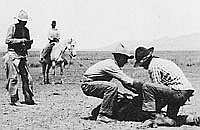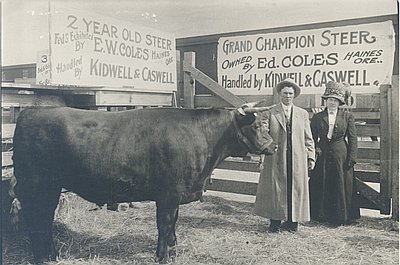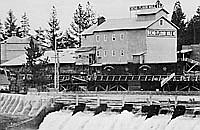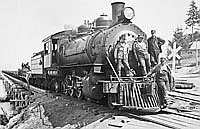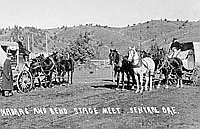Survival on the High Desert
The first Euro-American immigrants to central Oregon were livestock ranchers, but they practiced subsistence farming. They watered their garden plots with the domestic water supply. To grow larger amounts of fruits or vegetables, they needed to access additional water sources. In most of central Oregon, water for irrigation was available only by diverting surface water from higher elevations. This was an expensive job and well beyond the means of most individuals. The alternative to irrigation was “dry farming,” a term used throughout the West to refer to farming arid land without irrigation.
As Americans moved into the West in the 1880s and 1890s, they were learning about the special techniques required for dry farming, which were unknown in Europe or in other areas of the United States. Schools of agriculture at land grant colleges conducted research on dry farming, and farmers collected empirical data in their traditional way. Dry farming congresses and expositions were held to foster knowledge of the new practices. In general, dry farming was most successful with cereal crops and certain legumes like lentils, field peas, and alfalfa. Northern slopes were preferable, and most fields could be planted only on alternate years. The “fallow” years were necessary to re-charge the soil moisture and nutrients. Certain areas like the Agency Plains, Powell Buttes, the Crooked River Valley, and Tygh Valley were favorable for dry farming, while other areas were not.
J.M. Bird, the Sheriff of Wasco County, visited the upper Deschutes country in 1870, and his letter to The Dalles Mountaineer summarizes the first settlers’ farming experience: “I found a large quantity of hay put up, and in the vicinity of the forks [of Ochoco Creek] I found some very fine crops of grain had been raised, which seemed to yield as well as any portion of Eastern Oregon. I am of the opinion that vegetables are not a certain crop in the valley...as they have late and early frosts.”
The settlers were soon to discover that fruit trees were also “not a certain crop” because of the brutal frosts in April and May.
Central Oregon homesteaders could not easily meet the Jeffersonian ideal of independence and self-sufficiency. An energetic homesteading family could expect to grow grass hay for their livestock, grain for feed or domestic use, and they could plant a big garden. Some vegetables would be reliable—especially root crops and cruciform vegetables—but fruits and the more delicate vegetables like tomatoes or celery were too chancy. Alberta McCabe and her family homesteaded in 1910 near Cline Falls. She had a large garden supplemented by glass-covered “hot beds” that started her plants. She mentioned lettuce, radishes, and onions.
The McCabes planned to plant irrigated potatoes in the spring of 1912, but noticed that “everyone is putting in a large acreage [of potatoes] this spring so they will be giving them away next fall.” The McCabes had fruit and other produce brought in by team from the Willamette Valley. Buying these supplies required cash. Ernest McCabe worked as a teamster and his wages provided some income, but the family’s agricultural activities probably did not produce much cash income. As a result, their finances were always strained: “Far and away too much [money] has gone this last year for expenses, as [Ernest] has never been able to get far enough ahead to buy in quantity. He is going to try to cut these down in every possible way from now on, and see if the credit side won’t look better by another year.”
In most parts of central Oregon, the dry farmers scraped by, and in certain areas like the Agency Plains, they prospered. In the first few years of farming, the residual soil moisture helped many dry farms produce respectable stands of wheat or rye. The first decades of the century also enjoyed high levels of precipitation, and World War I created an advantageous market for food and fiber. These conditions created hopes that were dashed in the dry years and hard times of the early 1920s. Dry farming communities on the high desert east of Bend, or on the lower desert, or in other less favored places failed. These included Lamonta, Imperial, Opal Springs, Pringle Flats, Geneva, and other towns typically promoted by developers and sold to unsuspecting newcomers. The buildings lasted for a few years after the settlers left, then they were razed for their lumber, or blasted by bombing practice during World War II.
The solution to agriculture in central Oregon and other parts of the arid West was, of course, irrigation. Settlers in central Oregon dug small ditches almost as soon as they arrived if they had access to surface water. In the 1870s, settlers on Squaw Creek were irrigating small plots, and Andrew Jackson Tetherow was irrigating his hay fields on the Deschutes. In the 1870s and 1880s, irrigation was a national topic. Writers like John Wesley Powell, who headed the U.S. Geological Survey, and William Elsworth Smythe, who edited the magazine Irrigation Age, recognized that the settlement of the arid West would require large-scale irrigation projects created with the help of the federal government. These would be large enough to impound water at higher elevations, store it though the winter and spring, and deliver it to farmers through a system of canals during the summer.
The Carey Act of 1894 and the Newlands Reclamation Act of 1902 provided a federal program to irrigate large tracts of the public domain and distribute them to settlers. Central Oregon was a logical place for Carey Act irrigation projects since most of the land was in the public domain, and the east slope of the Cascades provided an ample supply of water. In 1907, the state engineer published a map of the upper Deschutes country showing six Carey Act projects potentially irrigating 254,963.58 acres: Columbia Southern Irrigating Co., 27,004.83 acres; Deschutes Reclamation & Irrigating Co., 1,280.00 acres; Squaw Creek Irrigation Co., 11,766.84 acres; Deschutes Irrigation & Power/Pilot Butte Segregation, 84,707.00 acres; Deschutes Irrigation & Power/Oregon Irrigation Segregation, 56,006.89 acres; Deschutes Irrigation & Power/Benham Falls Segregation, 74,198.02 acres.
These acreage figures indicate the amount of land potentially irrigated by each project. The acreage actually irrigated was much smaller. In 1922, the Federal Power Commission estimated that 35,608 acres of central Oregon had been supplied with water, and that 29,031 acres were in fact planted.
© Ward Tonsfeldt and Paul G. Claeyssens, 2004. Updated and revised by OHP staff, 2014
